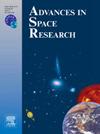用于低地轨道防撞的阻力增强装置
IF 2.8
3区 地球科学
Q2 ASTRONOMY & ASTROPHYSICS
引用次数: 0
摘要
近地轨道空间碎片的扩散使得开展有效的避碰机动的迫切性日益突出。这项工作提出了一个开创性的框架,旨在为增阻小型平台设计一种新颖的避碰机动设计。该框架通过改变截面积来调整卫星的弹道系数,从而改变卫星的阻力加速度。这种方法在标称轨迹上产生可控偏差,为避免碰撞提供了可行的解决方案,而不需要推进器或燃料消耗。本文介绍了一种传播增阻机动的分析方法,并将其应用于避碰研究。提出了在数值传播器内实现这种机动的公式,以及为在避碰场景中应用增阻机动而开发的优化过程。实际应用展示了这些方法的适用性,证实了在低轨道中使用阻力增强操作来避免碰撞。此外,还讨论了该策略的要求和边界,包括高度限制和卫星特性。本文章由计算机程序翻译,如有差异,请以英文原文为准。
Drag augmentation for collision avoidance in LEO
Space debris proliferation in Low Earth Orbit (LEO) has heightened the urgency for effective Collision Avoidance Manoeuvres (CAMs). This work presents a pioneering framework aimed at devising a novel collision avoidance manoeuvre design for drag-augmentation small platforms. The framework facilitates the alteration of drag acceleration by adjusting the satellite’s ballistic coefficient through cross-sectional area changes. This approach generates controlled deviations in the nominal trajectory, offering a feasible solution for collision avoidance without necessitating thrusters or fuel consumption.
The paper introduces an analytical method for propagating drag augmentation manoeuvres and applies it for collision avoidance studies purposes. The formulation followed to implement this manoeuvre within a numerical propagator is presented, as well as the optimisation process developed for the application of drag augmentation manoeuvres in collision avoidance scenarios. Real-world applications showcase the suitability of these approaches, confirming the use of drag augmentation manoeuvres to avoid collisions in LEO. Additionally, the requirements and boundaries of the strategy, including altitude restrictions and satellite-specific properties, are discussed.
求助全文
通过发布文献求助,成功后即可免费获取论文全文。
去求助
来源期刊

Advances in Space Research
地学天文-地球科学综合
CiteScore
5.20
自引率
11.50%
发文量
800
审稿时长
5.8 months
期刊介绍:
The COSPAR publication Advances in Space Research (ASR) is an open journal covering all areas of space research including: space studies of the Earth''s surface, meteorology, climate, the Earth-Moon system, planets and small bodies of the solar system, upper atmospheres, ionospheres and magnetospheres of the Earth and planets including reference atmospheres, space plasmas in the solar system, astrophysics from space, materials sciences in space, fundamental physics in space, space debris, space weather, Earth observations of space phenomena, etc.
NB: Please note that manuscripts related to life sciences as related to space are no more accepted for submission to Advances in Space Research. Such manuscripts should now be submitted to the new COSPAR Journal Life Sciences in Space Research (LSSR).
All submissions are reviewed by two scientists in the field. COSPAR is an interdisciplinary scientific organization concerned with the progress of space research on an international scale. Operating under the rules of ICSU, COSPAR ignores political considerations and considers all questions solely from the scientific viewpoint.
 求助内容:
求助内容: 应助结果提醒方式:
应助结果提醒方式:


